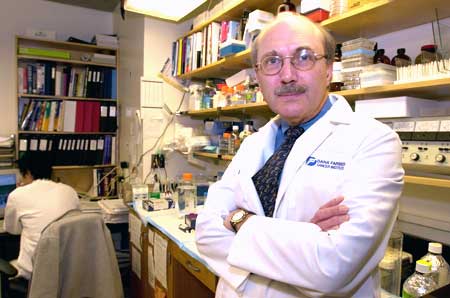Cancer vaccineIt’s being tested on kidney and skin cancer patients with promising results
Tumors were eliminated in 25 percent of patients with widespread kidney and lethal skin cancers who received a new cancer vaccine. Another 25 percent showed encouraging shrinkage of large and small tumors.
Some of the 75 people who have received the vaccine saw their tumors melt away within weeks and remain gone for two to three years to date. No toxic side effects, such as those that plague chemotherapy and radiation, have been reported.
“If confirmed by larger studies, these results represent an unprecedented advance in the selective and nontoxic treatment of cancers that have spread in the body,” according to Donald Kufe, professor of medicine at Harvard Medical School. The vaccine was developed in his laboratory.
It has been given to four women whose breast cancer has started to spread, or metastasize, as part of trials being conducted at Beth Israel Deaconess Medical Center and Dana-Farber Cancer Institute in Boston. The trials also include patients with metastasized kidney cancer and melanoma, a deadly skin cancer.
“We treated our first melanoma patient on October 24,” says David Avigan, who is conducting the studies with Kufe. “Our plan is to treat 20 patients in each trial (breast, kidney, and skin cancers) to evaluate the safety of the vaccine and, possibly, find hints of its efficacy. Such studies should take a year and, if successful, will lead to further trials with about three times as many patients.”
Kufe also intents to test the vaccine on other types of the disease, including prostate cancer, in the near future.
Some 45 kidney patients have been given the new vaccine at the University of Göttingen in Germany. “This disease spreads to the lungs, bones, and brains, and is extremely difficult to treat,” Kufe comments. Other researchers in Berlin are treating people with melanoma.
In both experiments, the vaccine has eliminated or shrunken tumors in about half the patients without any debilitating side effects.

Amazing results
Kufe says he was “impressed and excited” about the results when he visited Göttingen last year. A patient from Switzerland showed up with a large tumor in his lungs and several smaller tumors that had spread from his kidneys. Less than six weeks after vaccination, the main tumor had shrunk to a quarter of its original size and the smaller tumors disappeared.
Another patient suffered from kidney cancer that had spread to her brain, an extremely hard situation to treat. It required six vaccinations over six months, but her brain tumor finally went away.
Everyone has been “amazed” at the results, Kufe says.
He and his colleagues are now trying to repeat the success of the German experiments, a necessary step to obtain approval from the Food and Drug Administration to give the vaccine in the United States. Kufe thinks this can be done in one year. At the same time, he hopes to prove the safety of the vaccine for breast cancer and melanoma.
Tumors reject themselves
Kufe started working on the vaccine in the early 1980s. He built on the work of Baruj Benacerraf, Harvard’s George Fabyan Professor of Comparative Pathology Emeritus, who won a Nobel Prize in medicine in 1980 for discoveries about how the body’s defenses fight tumor growth.
By 1997, Kufe had created a vaccine that effectively treated tumors in mice. Other cancer vaccines now under development rely on stimulating the body’s immune system to attack a specific protein made by tumor cells. However, such targets are difficult to identify. Also, Kufe notes, the target may move, that is, the protein may figure out a way to change, as do proteins on the flu virus.
Kufe’s team, including postdoctoral researcher Jianlin Gong, avoided these problems by combining cells from kidney tumors with immune cells from a patient’s blood. Tumor cells contain all the possible target proteins. The immune cells arouse the body’s defenses to find and attack every one of them, whether their identities are known or unknown.
In contrast to vaccines against flu or polio, which prevent these diseases, the hybrid vaccine causes the body to reject tumor cells already present.
When the German researchers read Kufe’s reports, they decided to try the vaccine in humans. That’s easier to do in Germany than in the United States, where the Food and Drug Administration requires extensive tests to demonstrate the safety of a new vaccine, a process that takes years.
One big worry involved the possibility that the hybrid vaccine might induce the defense system to attack normal cells, causing the body to reject parts of itself. Such a side effect, known as an autoimmuity, has not occurred so far in three years of testing.
Freezing the tumors
In the event of continuing success, Genzyme Molecular Oncology, a biotech company in Framingham, Mass., is proceeding with plans to build a facility to make the vaccine.
And the National Kidney Foundation is looking ahead to the day when a vaccine will be available for treating approximately 30,000 new cancer cases each year. The foundation plans to advise patients who undergo surgery to freeze and store their tumors. If their cancer should spread, this measure would provide the cells necessary to make a customized vaccine.
Someday, says Kufe, “the vaccine may be given after surgical removal of kidney or other types of tumors. It might become a less toxic way to prevent metastasis than chemotherapy or radiation.”
But hopes should not be raised too high too soon. While patients have survived without recurrence for almost three years, “the cancer could come back,” Kufe warns. On the other hand, he says, “fusion-cell vaccines could fulfill the promise anticipated from the success of vaccines against polio, smallpox, and other infectious diseases.”




